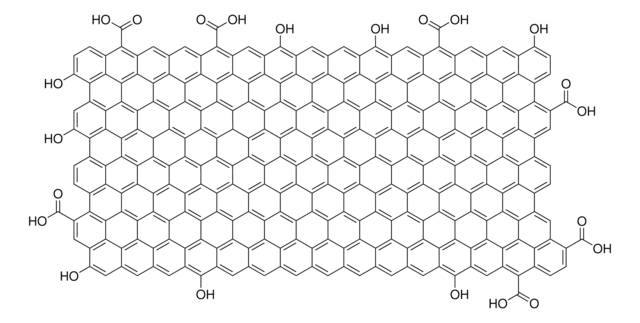This product is not tested for interlayer distance during the quality control process.
Wichtige Dokumente
796034
Graphenoxid
powder, 15-20 sheets, 4-10% edge-oxidized, avg. no. of layers, 15 ‑ 20
Synonym(e):
graphite oxide
Größe auswählen
About This Item
Empfohlene Produkte
Qualitätsniveau
Form
powder
Leistungsmerkmale
avg. no. of layers 15 ‑ 20
Löslichkeit
water: dispersible (polar solvents)
Schüttdichte
~1.8 g/cm3
SMILES String
O=C(O)C1C2=C3C4=C5C6=C7C8=C9C%10=C%11C(C%12=C%13C%10=C%14C8=C%15C6=C%16C4=C%17C2=CC(C(O)=O)C%18=C%17C%19=C%16C%20=C%15C%21=C%14C%22=C%13C(C%23=C%24C%22=C%25C%21=C%26C%20=C%27C%19=C%28C%18=CC(C(O)=O)C%29=C%28C%30=C%27C%31=C%26C%32=C%25C%33=C%24C(C%34=C%35C
InChI
1S/C140H42O20/c141-131(142)26-13-23-15-44-62(140(159)160)45-16-24-14-40-31(132(143)144)5-1-29-41-20-48(135(149)150)56-33-7-3-28-27-2-6-32-55-37(133(145)146)11-9-35-60(138(155)156)42-17-25-18-43-61(139(157)158)36-10-12-38(134(147)148)58-46-21-50(137(153)154)59-47-22-49(136(151)152)57-34-8-4-30-39(19-26)51(23)78-72(44)88-75(45)80-52(24)79(54(29)40)95-71(41)83(56)101-93-69(33)64(28)91-90-63(27)68(32)92-86(66(35)55)73(42)81-53(25)82-74(43)87(67(36)58)96-76(46)85(59)103-97-77(47)84(57)102-94-70(34)65(30)89(78)105-104(88)115-98(80)111(95)116(101)126-122-110(93)107(91)120-119-106(90)108(92)99(81)114-100(82)112(96)118(103)128(124(114)119)123-113(97)117(102)127(130(122)129(120)123)121(109(94)105)125(115)126/h2,5,7-10,12-22,26,38,48-50H,1,3-4,6,11H2,(H,141,142)(H,143,144)(H,145,146)(H,147,148)(H,149,150)(H,151,152)(H,153,154)(H,155,156)(H,157,158)(H,159,160)
InChIKey
VTWITIAIMADGRM-UHFFFAOYSA-N
Suchen Sie nach ähnlichen Produkten? Aufrufen Leitfaden zum Produktvergleich
Verwandte Kategorien
Allgemeine Beschreibung
- Form: Braunes/schwarzes Pulver
- Schüttdichte: ~1,8 g/cm³
- Löslichkeit: In Wasser und polaren Lösungsmitteln dispergierbar
- Anzahl an Schichten: 15-20
- Oxidation: 4–10 %
Anwendung
- Nanoverbundstoffe [1,2]
- Antikorrosionsbeschichtungen [3,4]
- Barrierefolien [5,6]
- Membranen zur Trennung [7,8]
- Elektrisch leitfähige Farben [9,10]
- Energiespeicher [11,12]
Lagerklassenschlüssel
11 - Combustible Solids
WGK
WGK 3
Flammpunkt (°F)
Not applicable
Flammpunkt (°C)
Not applicable
Hier finden Sie alle aktuellen Versionen:
Analysenzertifikate (COA)
Die passende Version wird nicht angezeigt?
Wenn Sie eine bestimmte Version benötigen, können Sie anhand der Lot- oder Chargennummer nach einem spezifischen Zertifikat suchen.
Besitzen Sie dieses Produkt bereits?
In der Dokumentenbibliothek finden Sie die Dokumentation zu den Produkten, die Sie kürzlich erworben haben.
Artikel
Since its discovery little more than a decade ago,1 the two-dimensional (2D) allotrope of carbon—graphene—has been the subject of intense multidisciplinary research efforts.
Graphene's unique properties spark interdisciplinary interest; its honeycomb structure offers electrical, optical, and mechanical marvels.
Novel Graphene‑Based Nanostructures Production, Functionalization, and Engineering
Catalytic water splitting produces hydrogen crucial for renewable energy, petroleum refining, and chemical industry applications like methanol production.
-
Can I get information about the interlayer distance of this product?
1 answer-
Helpful?
-
-
How can I determine the shelf life / expiration / retest date of this product?
1 answer-
If this product has an expiration or retest date, it will be shown on the Certificate of Analysis (COA, CofA). If there is no retest or expiration date listed on the product's COA, we do not have suitable stability data to determine a shelf life. For these products, the only date on the COA will be the release date; a retest, expiration, or use-by-date will not be displayed.
For all products, we recommend handling per defined conditions as printed in our product literature and website product descriptions. We recommend that products should be routinely inspected by customers to ensure they perform as expected.
For products without retest or expiration dates, our standard warranty of 1 year from the date of shipment is applicable.
For more information, please refer to the Product Dating Information document: https://www.sigmaaldrich.com/deepweb/assets/sigmaaldrich/marketing/global/documents/449/386/product-dating-information-mk.pdfHelpful?
-
-
How is shipping temperature determined? And how is it related to the product storage temperature?
1 answer-
Products may be shipped at a different temperature than the recommended long-term storage temperature. If the product quality is sensitive to short-term exposure to conditions other than the recommended long-term storage, it will be shipped on wet or dry-ice. If the product quality is NOT affected by short-term exposure to conditions other than the recommended long-term storage, it will be shipped at ambient temperature. As shipping routes are configured for minimum transit times, shipping at ambient temperature helps control shipping costs for our customers. For more information, please refer to the Storage and Transport Conditions document: https://www.sigmaaldrich.com/deepweb/assets/sigmaaldrich/marketing/global/documents/316/622/storage-transport-conditions-mk.pdf
Helpful?
-
-
Could you provide TGA results of these GO? I need a high thermal stability GO like 300-400 stable.
1 answer-
Unfortunately, thermogravimetric analysis (TGA) is not performed on this material. The decomposition temperature has not been established. Please see the link below to review an article which suggests that, in general, graphene oxide has a decomposition range by TGA from approximately 125 - 200°C.
https://www.sciencedirect.com/science/article/pii/S2667056923000068#:~:text=Based%20on%20the%20TGA%20and,decomposition%20of%20GO's%20surface%20functionalities.Helpful?
-
-
How can graphene oxide (P/N: 796034) be homogenized in a PBS solution?
1 answer-
The product 796034 is edge functionalized graphene. One method to homogenize it is to use a regular lab ultrasonic bath. The appropriate sonication time depends on the machine power, typically around 15-20 minutes for a 100 Watts ultrasonic bath. If the dispersion is not as expected, the sonication process can be repeated.
Another alternative is to use a homogenizer/cell crasher. A homogenizer with 400-600 Watts is recommended, and it's suggested to set the homogenizer to sonicate for 3 seconds and then pause for 1.5 or 2 seconds, with a total sonication time of 15-20 minutes. Similarly, if the powder is not fully dissolved, the experiment may be repeated.
Helpful?
-
-
What is the particle size of this product (796034, Graphene oxide)? Is it a nanoparticle?
1 answer-
While particle size is not an assigned specification for this product, an estimate is provided below:
d90 - 14.6 μm
d50 - 4.2 μm
d10 - 1.2 μmHelpful?
-
-
May I get the step-by-step procedure including the materials used to synthesize this product graphene oxide (796034)?
1 answer-
This is an MQ100 quality level product, this information is considered proprietary. All of the shareable documentation is on the product page or the documentation linked to on the product page. Synthetic and preparative details are proprietary.
Helpful?
-
-
Dear Sir/Madam, I am loohking for the thermophysical properties of Graphene Oxided product number 796034. Brand : Aldrich regards Adel
1 answer-
Unfortunately the thermophysical properties have not been tested for this product.
Helpful?
-
-
Do you have data on the diffuse reflectance spectra of eo-GO (796034)?
1 answer-
Unfortunately, reflectance spectra is not provided with this product.
Helpful?
-
Active Filters
Unser Team von Wissenschaftlern verfügt über Erfahrung in allen Forschungsbereichen einschließlich Life Science, Materialwissenschaften, chemischer Synthese, Chromatographie, Analytik und vielen mehr..
Setzen Sie sich mit dem technischen Dienst in Verbindung.






